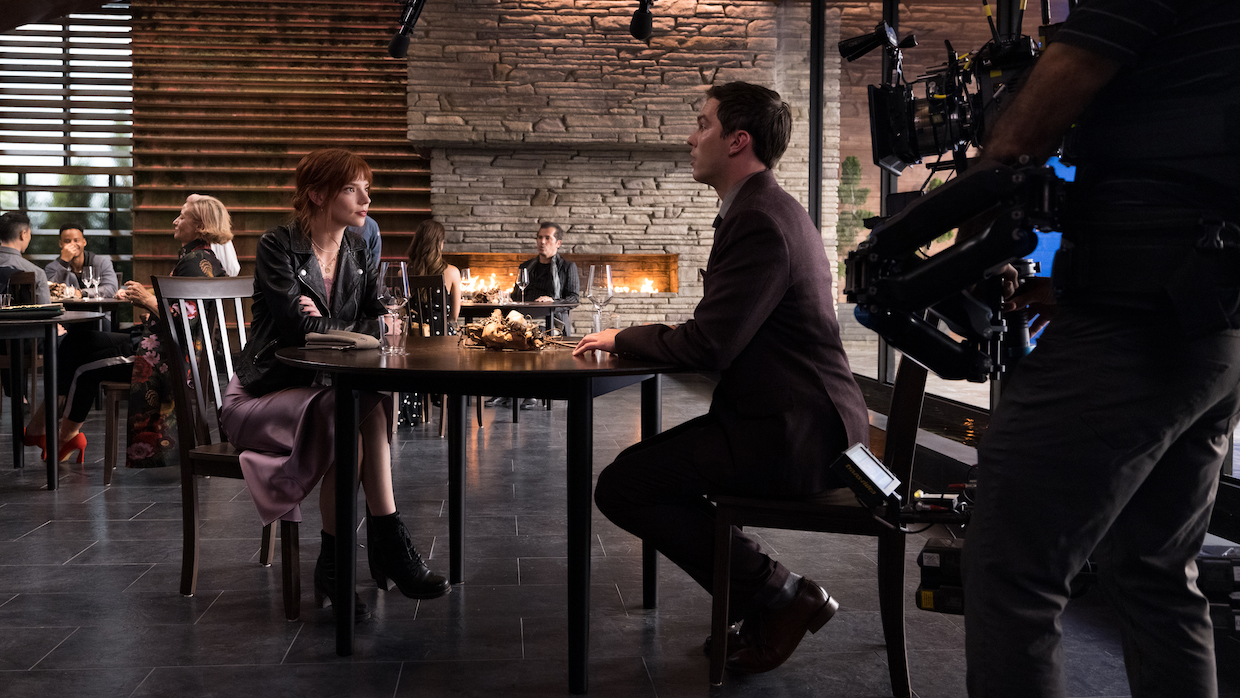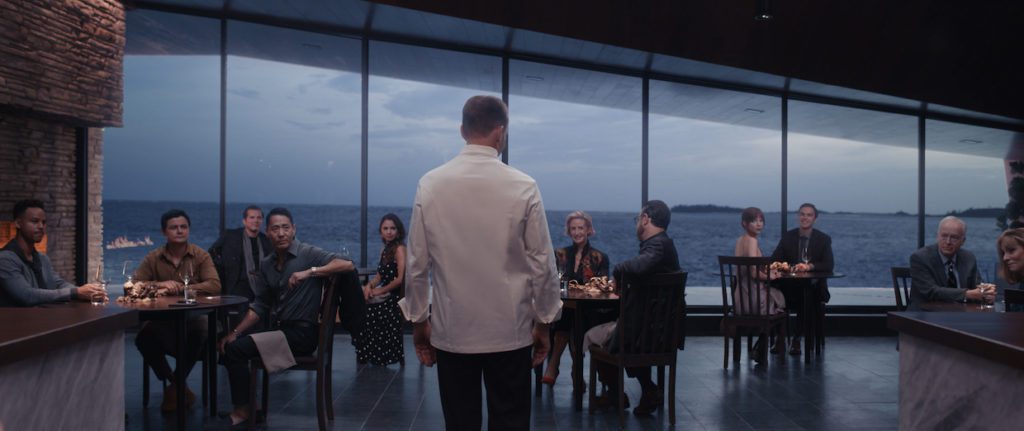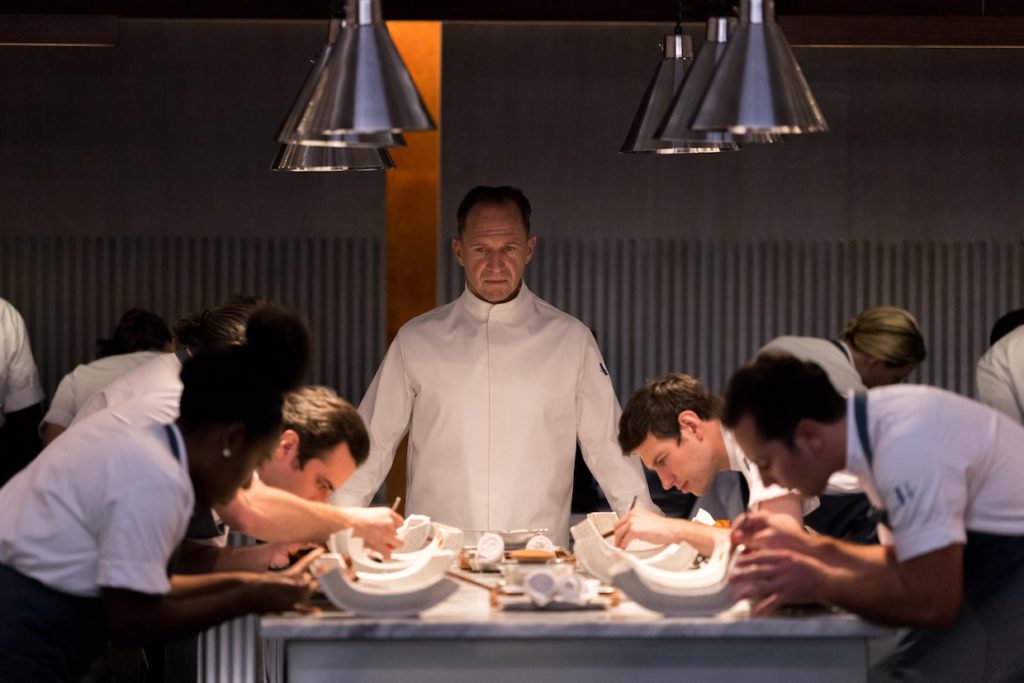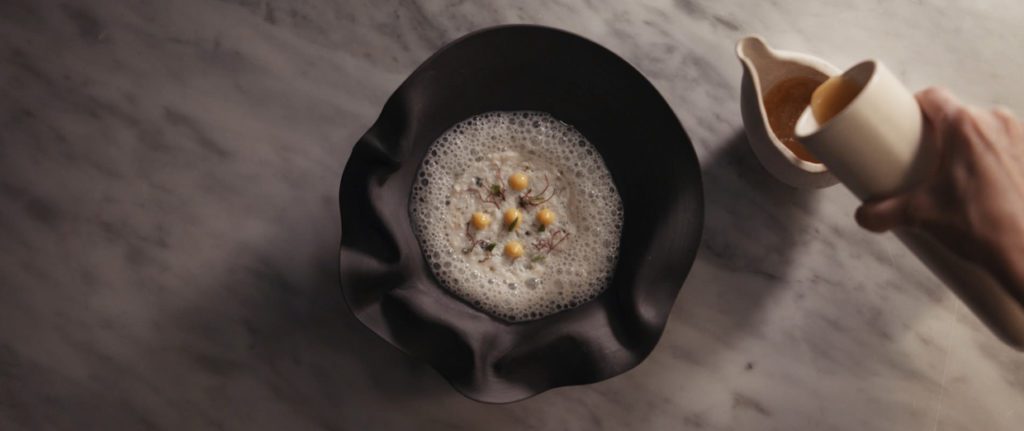 Back to selection
Back to selection
Shutter Angles
Conversations with DPs, directors and below-the-line crew by Matt Mulcahey
“Cameras are Like Film Stocks Now”: DP Peter Deming on The Menu
 Anya Taylor-Joy and Nicholas Hoult on set of The Menu (Photo by Eric Zachanowich, courtesy of Searchlight Pictures)
Anya Taylor-Joy and Nicholas Hoult on set of The Menu (Photo by Eric Zachanowich, courtesy of Searchlight Pictures) In The Menu, entitled dinner guests get more than they bargained for when they travel to a remote island to feast upon the culinary delights of a disillusioned celebrity chef (Ralph Fiennes). Despite being surrounded by exquisite works of gastronomical artistry during the shoot, cinematographer Peter Deming did not partake. “I didn’t taste any of it. I’m not a big food person,” said Deming. “I’ve actually talked to a number of people who said the first thing they did after seeing the movie was go have a cheeseburger.”
While Deming may not have an appetite for ornate cuisine, the cinematographer certainly knows the ingredients for comedy and horror and how to mix them. Deming’s first big break came with 1987’s Evil Dead II. In the decades since, he’s worked on both the hilarious (Hollywood Shuffle, House Party, My Cousin Vinny) and the horrifying (three Scream sequels, Drag Me to Hell, The Cabin in the Woods).
With The Menu now available on a multitude of platforms—including VOD, HBO Max and in theaters—Deming spoke to Filmmaker about creating Fiennes’ chic eatery in a Savannah, Georgia warehouse.
Filmmaker: You’ve shot a few of your recent projects—The New Mutants and The Good Lord Bird included–on the 8K Panavision DXL2. How did you land on the Sony VENICE for The Menu?
Deming: I had used the VENICE a bunch of times on shorter projects such as commercials and liked the outcome. But sometimes you can’t really QC a camera all the way through until you see it on a big screen, and I wanted to take the VENICE through that process. I didn’t really need the 8K for The Menu. Certainly, for visual effects, it’s great to have an 8K image for them to work with, but the visual effects were pretty minimal in this movie. This was also largely a studio movie. We had some location work, but we spent five of eight weeks in the restaurant. So, it wasn’t like there was a lot of handheld and I needed a smaller camera. To me it’s sort of like cameras are like film stocks now, and I was really interested in taking the VENICE through the paces on this one.
Filmmaker: The VENICE has a dual ISO mode where you can shoot at a 2,500 base. Was that part of the appeal, almost like opting for a faster film stock?
Deming: We actually didn’t shoot at 2,500 a lot. I haven’t done a comprehensive side by side with all these cameras, but they can all only be pushed to a certain limit. I find the people out there who know the most about that, certainly on set, are the DITs, because they come across all of the different cameras. So, I talk to them to see what their feedback is. Of course, a lot of people in the postproduction world pull apart the files more than anybody else, so they all have their own opinions as well.
Filmmaker: How much does shooting large format right now limit your choices of lenses?
Deming: There was a moment where it was like, “God, I’d love to use these lenses, but we’re on a large format sensor and I don’t want to just use that little part of the sensor.” Now, most of the lens manufacturers have been able to expand all these lenses [to cover large format sensors]. [On] The Good Lord Bird, which was a limited series that took place in the 1850s, we found some really old [Panavision] B Series anamorphics. Every lens was different. All the corners were soft. They were able to expand those lenses so we could use them with the DXL2. Maybe you’re losing a little sharpness in the process, but if you’re on an 8K or 6K sensor, then that’s sort of the look you’re going for now anyway, because you want it to have texture. It’s funny because as sensors got bigger and resolution got higher, everyone started going for more vintage glass, because you don’t want a digital look. Now, rental houses and manufacturers will take a perfectly good set of prime lenses and detune them for you. They’ll take the edge off and try to soften the corners.
Filmmaker: For the interiors, you used bluescreen out the windows for the side of the restaurant that faces the water.
Deming: Yeah, we used blue screen. We toyed with the idea of LED screens. We did actually shoot all the plates in prep so that we knew what they would look like and what we were matching to, but there would’ve been a lot of complications if we had used LED screens. The distance to the wall of our stage was 20 feet, which wasn’t great. The LED screens would’ve had to wrap and they would’ve taken away a lot of the lighting possibilities, because the screens would have to be so big to cover all the field of view of all the possible angles that the [movie] lights would’ve been fighting big time against the [LED screen luminance]. So, we decided to go blue screen, which I think was a smart decision.
Filmmaker: You shot the interiors in Savannah, Georgia in a converted warehouse?
Deming: It had been used for filming before, but I would say our set in that space was very challenging. The size of the stage negated some of the normal advantages of working on a stage. The set literally went to the roof of the warehouse because it was vaulted. Parts of the ceiling came out, but it really wasn’t advantageous to do that in terms of time.
Filmmaker: I imagine it was a nightmare to deal with reflections when you were facing the windows.
Deming: It was a big nightmare. The windows gimbaled, but only left and right, not up and down. [Being able to shift the angle of the windows] certainly helped, but at the same time if you gimbaled them too much then you had the same reflection in four different windows, which I think subconsciously to a viewer feels like a hall of mirrors. Suddenly you’re in The Lady from Shanghai. So, consequently, most of the lights were above frame. Occasionally we would lower them and hang a flag or teaser to hide it, but it was difficult to do that and have the light still do what it needed to do. What was interesting about it is that everyone was always on screen, even the kitchen staff, because they’re all in the reflections. So, they all had to keep doing what they were doing, and they had to match continuity.

Filmmaker: What lighting units did you use to create the different looks out that window, where you go from daylight to dusk to night?
Deming: As I said, the throw was really short, so we needed something broad and soft that we could fly and raise in and out depending on if we were seeing the windows. For that reason, we had four [Arri SkyPanel] S360s that were rigged horizontally because they gave us a full color range of anything we wanted, and we could adjust the intensity without flipping bulbs on and off and all that. Then we would either soften or not soften them depending on what the scene was. For the most part we softened them on the units, but occasionally we’d bring in a rag on stands. Once it got to night, that was a whole different ballgame. Story-wise, the beginning of the film starts fairly traditionally, then it gets wackier and wackier. One of the things that we talked about a lot in prep was, “We’re going to have to shoot so many closeups in this movie. How do we not make it monotonous?” Some of that just came off the shooting style. When [the guests] first get there, we’re sort of on the outside of the diners, moving around on medium and longer lenses and picking up dialogue here and there. Then as the film goes on, we get closer in on wider lenses to feel that immediacy with the diners. We go from dollies and tripods to a lot of Steadicam and some crane work. Then, eventually we just go handheld because it gets really wild. Some of my favorite shots are extreme closeups on people with three or four other characters in the background. You feel like you’re sitting at the table instead of just observing the movie.

Filmmaker: Now let’s talk about facing the other direction, when we’re more in the kitchen world. There is this line of demarcation in this open space between “the takers and the givers,” as Fiennes calls them, between the diners and the kitchen staff.
Deming: The lighting in the kitchen remained fairly constant, though we did make some subtle changes along the way. No matter what we’re doing lighting-wise in the rest of the restaurant—whether it was day and some of the light coming in was cooler—those lights in the kitchen were tungsten and dimmed a little bit, so they were always going to be warm. The challenge was that the surfaces in the kitchen were a marbled white. Obviously, that’s going to clip out. So, for a lot of the angles towards the kitchen, I would try to lower the camera enough where [those counters] became two-dimensional lines. You saw what [the staff] was working on, but you didn’t have to see that surface and then the surface became a big bounce card. That was great for some of the stuff of Ralph’s character, because he had this really soft underlight that wasn’t overly sinister but gave him a creepy vibe that we enhanced as the film went on.

Filmmaker: Tell me about shooting the food, particularly the close-ups.
Deming: [Director] Mark Mylod and I looked at a lot of high-end food shots, both motion and stills. One thing that stood out to me was that the focus was always very shallow, and the shots were designed so that the food they wanted to display was sharp and the rest was soft and ethereal. We could treat the food shots that way, but I felt like they should also remain in the environment. If you’re seeing a dish as it’s in the kitchen, then the close-ups should be shot in the kitchen. Then, probably three or four months into post, Mark really wanted to add some of these Chef’s Table shots. Those are pretty obvious, because they’re in a black world with fog and they’re very elaborate. Those shots are cool. I really like them. My fear in designing the shots for the film was that if we did that style for everything, it would sort of out of being “viewer as diner.” But I think once those shots start appearing in the film, we are far enough into the journey that it is sort of comedic in a way.
****Spoiler alert****
Filmmaker: Let’s talk about the s’mores shot at the end of the film. You mentioned that the stage you were working in wasn’t particularly tall. Was it difficult to get high enough to get that overhead tableau?
Deming: The whole production method of doing that scene was really well thought out and well done. They came in when we weren’t shooting, laid everything out and photographed it with stills. They numbered [the spots where each part of the s’more would go] and put blacklight markings on the floor so that they could quickly go in when we were shooting [and dress the set], which was absolute genius. The graham cracker crumbs were pretty easy, but all the liquids became problematic as far as using them on the shooting day. I would say 95% of the liquid in our top shot was vinyl created based upon the reference stills. In terms of that overhead shot, we literally attached the hot head to the ceiling of the warehouse. We could not get any higher and that was our widest lens.
Filmmaker: Now that we’ve talked about the ending, let’s circle back to the beginning, The first shot is a close-up of Anya Taylor-Joy lighting a cigarette, which we later learn is a big foodie faux pas because it affects your sense of taste.
Deming: That is a stock shot.
Filmmaker: No! Really?
Deming: When I saw the first cut, I was like, “Oh, that’s interesting. They got a stock shot that fit into the movie.” And the more I looked at it, the more I had issues with it. Thematically, it’s a perfect way to start the movie. There are some technical issues with the shot itself, which I won’t bring up, but no one notices it. Even I didn’t notice [those issues] the first two or three times I saw it. It wasn’t until we got into the color correction on the film and I was like, “….wait a minute.” (laughs)
Filmmaker: Was the original first shot just a wide of the characters on the dock?
Deming: No, we actually did a shot—and I don’t know if it was too off-putting or what—of a fish in the water and it had this fish oil around it, and you could see the dock. It was a 45-degree angle down and you felt the people walking in the reflection. It was actually complicated to get that shot, but we did eventually get it. I’m sure in a test screening it was like people were put off or disgusted by it or something. (laughs) But maybe it’ll make it into the DVD extras.
